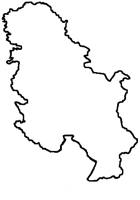
|
The Society of Folk Dance Historians (SFDH)
Vlach Dances from the Village of Osnić
[
Home |
About |
Encyclopedia | CLICK AN IMAGE TO ENLARGE |

|
 Osnić is a village in East Serbia, near the town of Boljevac, which is inhabited by a Yugoslav minority known as "Vlasi" (Valaši). The word "Vlasi" (or "Vlah" in the singular) has obscure, complex origins dating back to the early Greek form "Vlachoi." It refers not only to a Romanian-related linguistic group, but through the centuries has been used in the Balkans to denote, sometimes even in a derogatory sense, that which is foreign ("not one of us"), "primitive," pastoral, nomadic, et cetera.
Osnić is a village in East Serbia, near the town of Boljevac, which is inhabited by a Yugoslav minority known as "Vlasi" (Valaši). The word "Vlasi" (or "Vlah" in the singular) has obscure, complex origins dating back to the early Greek form "Vlachoi." It refers not only to a Romanian-related linguistic group, but through the centuries has been used in the Balkans to denote, sometimes even in a derogatory sense, that which is foreign ("not one of us"), "primitive," pastoral, nomadic, et cetera.
My informants in Osnić, a mountain village, refer to themselves as "Ungurijani," a meaning related to "the Hungarians," and call the neighboring "Vlasi" lowlanders, "Carani," meaning "peasants," or those who work the earth.
When the Slavs arrived in the Balkan Peninsula during the sixth and seventh centuries, the "Vlasi" were already established as primarily pastoral people scattered through the area as far south as Thessaly, in Greece, and were speaking a language related to Latin.
DANCE CHARACTERISTICS
Typical characteristics of Vlach dances in this general area are: stamping, shaking-bouncing, and twisting. The dance names often refer to the movements characteristic of the dance, for example: "Batuta" or "Ropota" – stamping, "Tramuriša" – shaking; and also to names of animals, for example: "Šok'c" – the rat, "Jepura" – the hare, and "Vakarijaca" – herd of cattle.
STYLISTIC NOTES FOR THE DANCES OF OSNIĆ
The women are often being sharply twisted by the men in the direction of each step, that is, stepping on R ft, R hip twists back on a horizontal plane. This movement is instigated by the men who yank on the women's belts with each step. Dancing is done on the whole foot.
Used with permission of the author.
Reprinted from the 1981 University of the Pacific (Stockton) Folk Dance Camp syllabus.
This page © 2018 by Ron Houston.
Please do not copy any part of this page without including this copyright notice.
Please do not copy small portions out of context.
Please do not copy large portions without permission from Ron Houston.